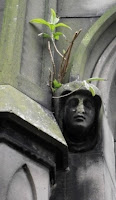Allow me - incompetently, inadequately, based on my brief acquaintance of a mere four days - to introduce you to Scotland's capital city, Edinburgh, a concoction of old medieval buildings and newer Georgian structures arranged on the kind of uneven terrain I so love and that often gives cities the basis of their character. There have been settlers in the area since at least the Bronze age. Since then the buildings have gotten a lot broader and considerably higher, but some of its modern residents on a Saturday night seem to pay homage to that ancient history.
It's an ocean town, but it doesn't feel like it, for the water's still a good step away from the city's two-chambered heart. The seagulls may remind you of it with their squawking and chortling, but there are also crows cawing from unseen edges of those tall solid buildings and little woodland creatures (assorted birds in blue and black and white, city-smart squirrels who know to make use of pedestrian crossings). The most dominant features of the city are those of the land rather than the sea: Edinburgh Castle is perched up high on the stone of a dead volcano so cunningly that at times it's uncertain where geological forces end and human construction begins; Arthur's Seat long ago plunged its head out of the earth and decided it liked it, and still sits with its stone edges watching across the land. The air in general was cool and crisp, though at night in particular you can smell cigarette smoke and malt lingering in the maze of streets. There's piping on Princes Street all through the daytime.
I was feeling somewhat unwell getting on the train from York - which, it may be noted, travels at 125mph to get you to your destination in about 2 hours - and so my first arrival in Scotland was somewhat less full of the delighted awe I had envisioned (I had to restrain myself from fainting on arrival at the first hostel, though that was partly down to the change in temperature from what seemed in my state an Arctic cold outside to a tropical wave of heat slapping me upside the face). I did however have my own private moment of general meaningfulness when the train itself was initially departing and was assured, after I managed to comment that my grandfather would have been pleased that I was going to Scotland, that "Your whole family's pleased. I'm pleased. Everyone on this train's pleased you're going to Scotland." They were all stoked as.
 |
| Sleeping with the fishes. |
 |
| A morning stroll before that infamous Edinburgh castle. Unfortunately, I left my poser's pipe behind. |
 |
| A very large grasshopper eats time in the National Museum of Scotland. |
There is a restaurant I must highly recommend, going by the name of David Bann. Precisely as Jessie had described to me, it is the kind of place you would take a carnivore to persuade them that a meal without meat can be delicious. The meals were beyond delicious. Our smoked tofu starter had an incredible texture and tasted remarkably like smoked fish and I savoured every bite. She had a mushroom strudel for her dinner, with a rich and hearty flavour; I had koftas with a zesty fresh salad and aubergine sauce. Oh, aubergine, how I love thee. And yet my ardour for the aurbergine cannot compare to the passions excited by the dessert - a panacotta in whiskey-soaked pears with some sweet smooth citrus sauce and a scattering of pomegranate seeds. I don't know if I have ever tasted, or will ever taste, something so fine again. I almost said that I wished I had taken a photograph of it, but I'm glad I didn't. Had I done so I may have sentenced myself to a life of pining. This way, I can at least try to move on.
Instead of a panacotta, here is a photograph of a door in a cafe that we had lunch (I had fresh duck salad; she had cauliflower and blue cheese soup) in:
 |
| Possibly a pirate was buried here. |






No comments:
Post a Comment